
The Center for Disease Control describes disability inclusion as “understanding the relationship between the way people function and how they participate in society and making sure everybody has the same opportunities to participate in every aspect of life to their best abilities and desires.” Most children, from a young age, are taught to include everyone and not leave their friends out. Parents teach their children the importance of having friends in everything. No one likes to feel left out or alone.
Learning about inclusion in our daily lives can help those with Autism Spectrum Disorder (ASD or autism) learn to communicate and feel comfortable in everyday situations. When teaching inclusion to children, it begins with parents. Children learn from and imitate what their parents do. A child learns that despite how others look, think, or act, it’s important to include them in our everyday activities. For a child, inclusion looks different than an adult. A child can ask a friend to play with them, partner with someone other than their best friend, or ask a new student at school to lunch. Inclusion for a young child seems like an easy task. As we grow older, inclusion becomes more of a challenge. How can we continue to empower and include those who are different as we grow older?
As with most things in life, inclusion starts with you. Rather than avoiding the differences in people, we need to learn to embrace others. Have uncomfortable conversations and seek those who may act differently. For example, rather than having the knowledge that someone you love has ASD, talk with them. Take them to lunch or a coffee shop and talk or simply enjoy their company. Learn to see the world from their perspective. Ask them questions and learn about their life. There is no better way to learn about autism than from someone who understands it better than you. As we educate ourselves, we must learn from others. We can research and state facts all we want, but the truth about ASD is that every person is unique. ASD may look one way for your child but different for another child.
At home, teaching inclusiveness shows children it is okay to ask questions. A home is a safe place for children to grow in understanding. They must learn to respect others despite their differences. Children view differences at school, parks, and grocery stores. Day-to-day they experience different religions, cultures, and ways of life. When children have experiences out of their comfort zone, they begin to ask questions. When they find answers to these questions, they begin to grow. For example, Inclusion Matters is a nonprofit organization that brings all children together through field trips and playtime. The goal of this nonprofit is to end stereotypes toward children with disabilities. Two students with a child with disabilities spend the day playing and having fun. Before the day begins, each student meets their buddies and learns about them. Following their field trip, each student walks through a 45-minute reflection time. Students reflect on how their beliefs and understandings of children with disabilities changed during reflection. Their experience teaches them how to treat and include others in the future.
Inclusion creates a space for those with disabilities to succeed to their most remarkable ability in the workplace. How do we do this? Much like a parent teaches a young child the appropriate ways to communicate and interact with others, leadership in the workplace must set the boundaries and expectations of inclusion. Good leadership must learn to recognize the talents of people with disabilities and understand the importance of empowering and fostering relationships. Training for employees and making buildings more accessible is a great start—teaching inclusion and correct language help make the workplace inviting and comforting.
Leaders in the workplace and schools are beginning to take steps to teach inclusion. Organizations like Hope For Three or Inclusion Matters foster inclusion in their communities. These are significant steps toward empowering our young and seasoned with disabilities. Inclusion can mean speaking to a small group of friends at school in our personal lives. It can be inviting someone to eat lunch when they are sitting alone. Holding rallies, fundraisers, or training is a step in the right direction for larger organizations. We can begin to create friendships that empower others to achieve when inclusion starts at home.
Authored by Ashley Beck
Sources
https://www.brighthorizons.com/family-resources/how-to-raise-inclusive-child
https://inclusionmatters.org/education-program/
https://www.autismspeaks.org/tool-kit-excerpt/teaching-peers-about-autism
https://researchautism.org/the-importance-of-peers-in-inclusive-education-for-individuals-with-asd/
https://fairforceberlin.medium.com/7-ways-to-be-more-inclusive-in-your-everyday-life-9af5ee018372
https://www.cdc.gov/ncbddd/disabilityandhealth/disability-inclusion.html
https://www.respectability.org/inclusive-philanthropy/how-to-include-people-with-disabilities/
For information on making your classroom more inclusive, visit educator and author Nicole Eredics:
https://www.friendshipcircle.org/blog/2014/02/21/10-items-that-can-make-your-classroom-more-inclusive/
http://www.theinclusiveclass.com/